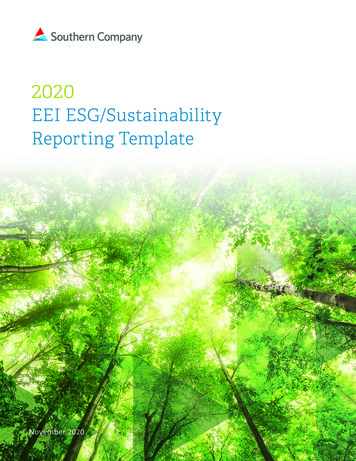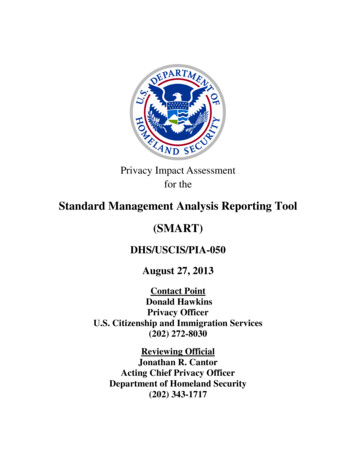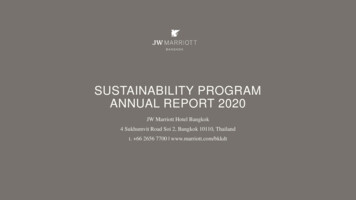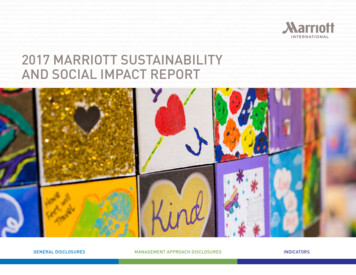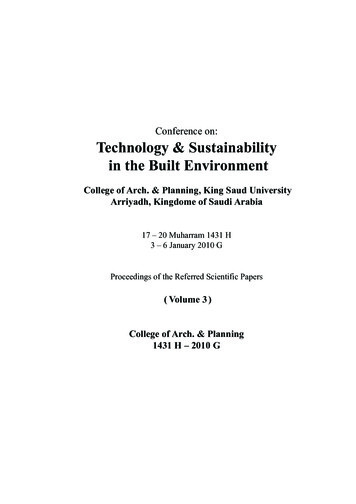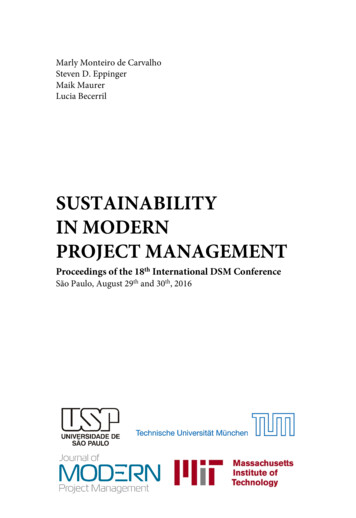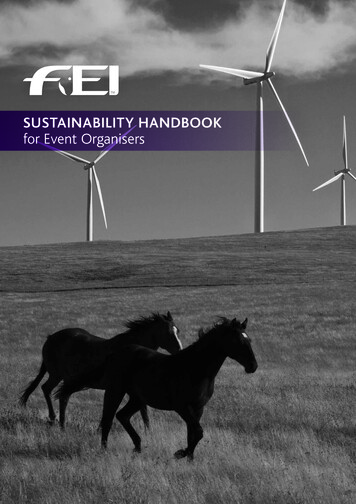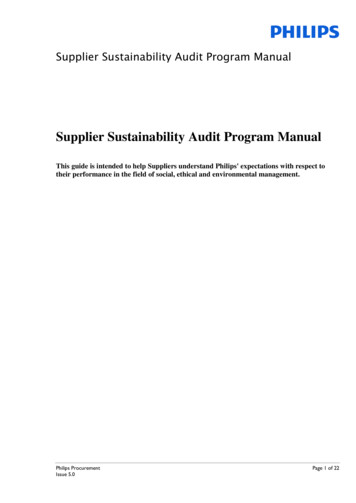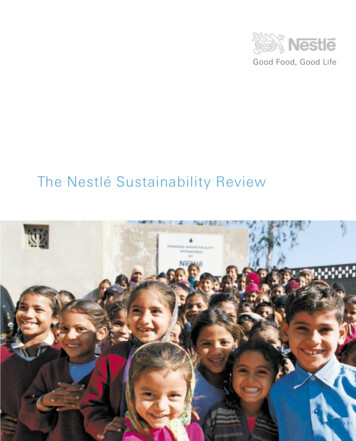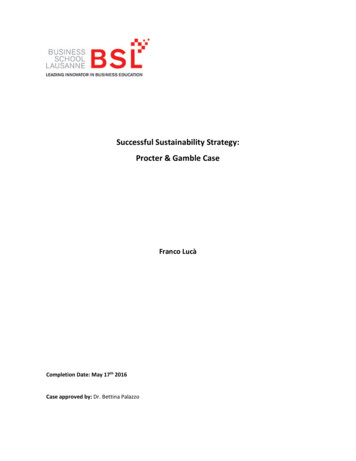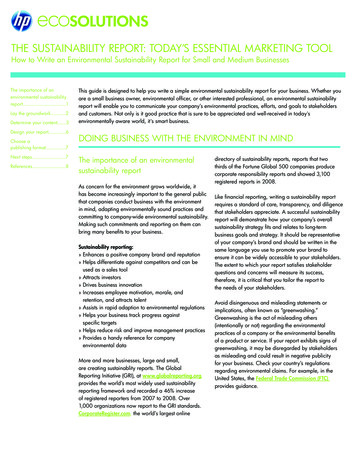
Transcription
THE SUSTAINABILITY REPORT: TODAY’S ESSENTIAL MARKETING TOOLHow to Write an Environmental Sustainability Report for Small and Medium BusinessesThe importance of anenvironmental sustainabilityreport.1Lay the groundwork.2Determine your content.3Design your report.6Choose apublishing format.7Next steps.7References.8This guide is designed to help you write a simple environmental sustainability report for your business. Whether youare a small business owner, environmental officer, or other interested professional, an environmental sustainabilityreport will enable you to communicate your company’s environmental practices, efforts, and goals to stakeholdersand customers. Not only is it good practice that is sure to be appreciated and well-received in today'senvironmentally aware world, it's smart business.DOING BUSINESS WITH THE ENVIRONMENT IN MINDThe importance of an environmentalsustainability reportAs concern for the environment grows worldwide, ithas become increasingly important to the general publicthat companies conduct business with the environmentin mind, adapting environmentally sound practices andcommitting to company-wide environmental sustainability.Making such commitments and reporting on them canbring many benefits to your business.Sustainability reporting:» Enhances a positive company brand and reputation» Helps differentiate against competitors and can beused as a sales tool» Attracts investors» Drives business innovation» Increases employee motivation, morale, andretention, and attracts talent» Assists in rapid adaption to environmental regulations» Helps your business track progress againstspecific targets» Helps reduce risk and improve management practices» Provides a handy reference for companyenvironmental dataMore and more businesses, large and small,are creating sustainablity reports. The GlobalReporting Initiative (GRI), at www.globalreporting.org,provides the world’s most widely used sustainabilityreporting framework and recorded a 46% increaseof registered reporters from 2007 to 2008. Over1,000 organizations now report to the GRI standards.CorporateRegister.com, the world’s largest onlinedirectory of sustainability reports, reports that twothirds of the Fortune Global 500 companies producecorporate responsibility reports and showed 3,100registered reports in 2008.Like financial reporting, writing a sustainability reportrequires a standard of care, transparency, and diligencethat stakeholders appreciate. A successful sustainabilityreport will demonstrate how your company’s overallsustainability strategy fits and relates to long-termbusiness goals and strategy. It should be representativeof your company’s brand and should be written in thesame language you use to promote your brand toensure it can be widely accessible to your stakeholders.The extent to which your report satisfies stakeholderquestions and concerns will measure its success,therefore, it is critical that you tailor the report tothe needs of your stakeholders.Avoid disingenuous and misleading statements orimplications, often known as “greenwashing.”Greenwashing is the act of misleading others(intentionally or not) regarding the environmentalpractices of a company or the environmental benefitsof a product or service. If your report exhibits signs ofgreenwashing, it may be disregarded by stakeholdersas misleading and could result in negative publicityfor your business. Check your country’s regulationsregarding environmental claims. For example, in theUnited States, the Federal Trade Commission (FTC)provides guidance.
LAY THE GROUNDWORKBefore you begin your environmental sustainability report, make sure you do the following:» Gather top management and leadership support.Their support is not only necessary for the project to move forward, their level of enthusiasm towards theproject could mean the difference between a good report and a great report.» Determine your audience.Who will read the report? Your audience might include your customers, employees, community members,special interest groups, and investors.» Gather a cross-functional team of contributors.Ensure you have participation from all areas of your company. Parties involved can include legal counsel,environmental health and safety, and information technology. In small companies, one person may fill all ofthese roles.» Determine a reporting strategy.Your strategy can be as simple as following this guide, or it could be expanded to follow a specificreporting standard, such as the GRI.» Determine the scope of your report and the key issues it will address.Focus on the issues that are most important to your audience or on the areas of your company that mostimpact the environment.2
KEY TERMSANDRESOURCESDETERMINE YOUR CONTENTHere are a number of recommended section headings for your sustainability report, along with brief explanations,tips, examples, and other useful information. Your own report does not have to include all of these headings. Selectthose that are relevant to your business and your stakeholders.Be aware of how you communicate your findings in your report, and avoid making sensational claims withoutsupporting data. The best reports are factual, balanced, transparent, and include negative aspects and areasfor improvement as well as highlighting successes.First pages1. Cover/title pageA strong cover page sets the tone and theme for your report, and should be representative of your company’sbrand. While it does not necessarily require professional photography or special graphics, you may wish toincorporate images relating to your business. A cover page is often necessary for PDF or print formats, andcould be useful for a Web-based report.2. Welcome statementA statement from your company's leaders emphasizes the link between environmental initiatives and overallbusiness strategy and management’s commitment to the goals in the report. It is meant to provide strategicand analytic insight rather than just a summary of the report contents.Corporate Register –The world's largest onlinedirectory of bal Reporting Initiative(GRI) – Network-basedorganization that haspioneered the development of the world’s mostwidely used sustainabilityreporting framework.www.globalreporting.orgGreenhouse Gases (GHG)Protocol Initiative –Widely used GHGaccounting tool, whichallows understanding,quantifying, andmanagement of GHG.www.ghgprotocol.orgThe statement should include:» Strategic priorities and key topics for the short- and medium-term (3 to 5 years)» Broader trends affecting the organization and influencing sustainability goals» Key events, achievements, and failures that occurred during the reporting period» Outlook on main challenges and targets3. Table of contentsA table of contents helps your readers find key sections of your report. Other features, such as Web links,glossaries, and indexes can also help provide further context for the report. Enabling the ability to searchon Web-based reports allows readers to locate keywords relevant and important to them.4. Introduction and organizational profileIntroduce the company’s areas of business, the industry, the number of employees (or other size indicator),and any other details that would help someone understand your company. Describe the business’ environmentalstrategy and goals and provide a summary of the report’s contents. Link these sections to overall businessstrategies and objectives (i.e. market share, profitability).Include a section in the introduction clarifying issues such as the scope, dates, and measure of the report toaddress questions and prevent confusion or misinterpretation of your report early on.Your organizational profile should include:» Primary products and services offered and markets served» Operational structure, including divisions, subsidiaries, and joint ventures» Countries of operation» Nature of ownership and legal structure» Net sales, revenues, and total capitalization in terms of debt and equity» Awards received during the reporting period3
BodyThe GRI provides some excellent guidance on how to scope your report and measure the importance of issueswithin that scope. In general, try to prioritize the significance of your environmental issues (or potential issues)based on the impact they have on your company, on the environment, and their importance to yourkey stakeholders.1. OperationsThis section considers the significant environmental achievements of your environmental sustainability strategy andreports on the impacts of your business activities, such as manufacturing, internal procurement, office space, andresource consumption. Typical aspects of this section are environmental compliance and management, resourceusage statistics, and waste production.Detailed guidance on measuring and documenting environmental performance indicators can be found in theGRI Indicator Protocols Set for Environment.Suggested content topics:» Environmental compliance and management systems:Discuss and report your audit results, non-compliances,fines, and environmental management systems relatedto your operations.» Energy and climate change: Discuss and reportelectricity usage, combustible fuel, renewableenergy usage, and energy and greenhousegases (GHG) reduction practices. Associate energyusage with GHG, and report the direct and indirectemissions. Information in this area can be gatheredfrom heating and electricity bills or by contactingyour energy supplier directly. There are severalways of compiling GHG statistics, from directmeasurements to calculations based on a commonGHG reporting protocol. Your country’s environmentalprotection government agencies may have GHGcalculators to assist you with metrics.» Waste management: Discuss and report yourpractices related to non-hazardous and hazardouswaste disposals and preventing and managingaccidental spills. Discuss your business’ recyclingpractices, if applicable. If a certain waste stream,such as cardboard, is significant, you might consideraddressing it in more detail. Key performanceindicators in this area can include total wastegenerated, waste diversion rates, and wasteaudit results. Information can be gathered fromwaste balance sheets from your provider ofwaste services or from your property managementcompany. Consider consulting your internal billingand accounting systems or procurement departmentsto gather information in this area as well.»W ater: Discuss and report water usage, wastewaterdischarge, and wastewater management practices.Information can be gathered from water bills, watermeters, and organizational estimates.»A ir emissions: Discuss and report air emissionsreleases by type, and any toxic releases ifapplicable. You can choose to report GHGreleases here or in your energy and climatechange section.» I nternal procurement practices: How doenvironmental sustainability concerns influencepurchases of internal supplies and equipment,such as office paper and computers? Discussyour purchasing policies or considerationstowards sustainability.» P roducts/service: Discuss the materials/ingredientsused in your products, manufacturing processes,and other environmental impacts associated withthe creation and use of your products and services.Be sure to mention how you are mitigatingthose impacts.» Information technology: Discuss your effortstowards establishing an environmentally responsibleIT infrastructure. This could span from data centerefficiency to optimizing your printer fleets. See thesidebar on page 7 of this report for HP resourcesto help you with these efforts.»O ther: Relevant topics may include transportation,property management, and packaging.4
2. Other environmental impactsThis section covers environmental impacts over which your business does not have direct control, but that canbe influenced by your business’ actions or the efforts of your management. These impacts typically result fromthe actions of your suppliers (resulting in an “embedded” environmental impact), and your customers or clients(affecting the environmental impact caused by your product after it leaves your property). Partnerships withsuppliers, retailers, manufacturers, or with non-governmental organizations (NGOs) and foundations outsideof the company are other areas you may want to report on. It is important to outline your targets and goalsin this section as well.» Supply chain: How are environmental sustainabilityconcerns affecting your choice of suppliers? Howare you attempting to influence the environmentalperformance of your suppliers?» Partnerships and sponsorships: Are you workingwith any NGOs, community groups, or othercompanies towards a common goal beneficial tothe environment? What have been the outcomes?» Customer outreach: How are you spreading themessage of environmental sustainability to yourcustomers and influencing their daily actions?Are you offering programs, services, or resourcesto help your customers use their products or servicesin an environmentally responsible manner?» Employee practices: Discuss your efforts to influenceemployee environmental responsibility at home andin the office.3. Goals and performance indicatorsInclude the operational goals and approaches you have taken in environmental sustainability, followed byperformance measures to allow for comparison and tracking (see Figure 1). This tells the reader where youare now and where you want to be. Bold, aggressive goals demonstrate a strong commitment to long-termenvironmental management strategies.4. Additional sectionsThis document focuses solely on environmental sustainability reporting. You may wish to include informationon other aspects of your company’s social responsibility efforts in your report, which could include volunteeractivities, social investment, employee benefits, and business policies around ethics. Some reports will also includea section on the economic performance of the company. For detailed guidance on how to write these types ofsustainability reports, the GRI provides thorough direction.Having a section dedicated to environmental or sustainability awards your organization has received is anotherway to communicate your achievements.Fig ure0: Haa separate performance andgo alsgosectionin yourreportallowsfor easviewingand andbrowsing. W e. sut havinga t leastFig ure0:vingHa vinga separate performance andals sectionin yourreportallowsforyeasy viewingbrowsingWggese su ggest havinga t leastthre ethreyeaersyeaofrsperform ancedata datashownif posifsible.of perform anceshownpos sible.Figure 1: Including a separate performance and goals section in your report allows for easy viewing and browsing. Provide atleast three years of performance data if possible.5
DESIGN YOUR REPORTEngage your readers with a visually appealing layout. Include actual photographs that illustrate and supportsections of your report, but avoid using irrelevant “green” imagery that does not relate directly to your report’scontent. Color coding and/or visibly dividing sections will make navigation easier, while careful attention tolayout can reduce wasted pages.Use graphics to convey and enhance your message (see Figure 2). If you want to showcase significant reductionsin certain sections of your business, graphs, tables, and highlight boxes draw reader’s attention to these areas(see Figure 3).Figure 2:In this graphic found inHP’s Global CitizenshipCustomer Report 2008,HP highlights its green ITinitiatives through a graphicalrepresentation of an office,which presents the informationin an engaging way.THE HPCREATIVESTUDIOCreate Your OwnSustainability Report –Download aprofessionally designedtemplate for your reportthat will help youorganize your content,add images andgraphics, and enhancereadability.www.hp.com/createFigure 3:Top left: HP’s product re-useand recycling rates over afour-year period are shownusing a graph.Top right: HP’s greenhousegas reductions and other keydata points are highlighted ina separate box.Below: HP’s packagingper product and total weightof packaging used from2005 – 2008 is presentedin a simple table.Fig ure 0:Lef t: H P’s produc t reu se an d r ecyc ling rates ove r a four -year period are shown using a graph.Fig ureRig0:ht: HP’s greenhouse gas redu ctions and other key da ta points are hig hligh ted in a separateLef t: boxH P’s. produc t reu se an d r ecyc ling rates ove r a four -year period are shown using a graph.s pac kagingproducttot otheral w eightpackagingused- 2008isRig ht:BelowHP’s: HP’greenhousegasperreductionsandandkey ofda tapoints arehigfromhligh2005ted ina separatebox . presen ted in a simp le ta ble.Below : HP’ s pac kaging per product and tot al w eight of packaging used from 2005 - 2008 ispresen ted in a simp le ta ble.6
CHOOSE A PUBLISHING FORMATDetermine the most effective method to distribute your report to your stakeholders. It is ideal to have morethan one option of distribution, as different users will have different preferences. The size of your report will alsoinfluence its formats, which could include:» Electronic PDF (most common format; can be e-mailed, posted to Web, saved to reusable USB drive)» Printed as a brochure or booklet (It is recommended that you use paper that is certified by the ForestStewardship Council (FSC) or the Sustainable Forestry Initiative (SFI), as well as paper with a highpercentage of post-consumer recycled content.)» Web-based report (Flash, HTML)Your report can also be supported by other media types, including:» Visual media (video, online photos)» Press releases» Presentations (speaking engagements, PowerPoint)NEXT STEPSNow that you’ve written your report, be sure to develop a communication plan to distribute your report toyour stakeholders. It is important that you take full advantage of your investment into the report by effectivelycommunicating it.After you have communicated your report to your stakeholders, there are three more steps you should considerthat will assist you in writing progressively better sustainability reports well into your company’s future:1. M easure progress over time. This means setting goals, possibly years in advance, and collectingaccurate, relevant data.2. Ask for feedback from stakeholders and other interested parties, and consider their recommendationsas you write your next report. Their opinions will be instrumental in ensuring your future reports areincreasingly relevant and effective.3. L earn even more about your own company by comparing your competitors’ reports to your own, lookingfor gaps or weak areas. Adjust your strategies accordingly.Improving your environmental sustainability reports over time ensures that your report becomes a tool to drivepositive, ongoing changes and continued strides towards sustainable business practices throughout your company.No matter what type of business you are in, taking a proactive approach to environmental sustainability isnot only a sound business decision, it’s smart strategy that will help you compete and succeed in today’s globalmarket. A sustainability report is an important outward testament to your commitment and should be considereda crucial component of any company’s business strategy and marketing efforts.HELPFULRESOURCESFROM HPHP Carbon FootprintCalculator for PrintersEstimate how powersaving technologies,efficiency features, anddevice consolidation canlower your energy usage.HP Creative StudioOnce you havefinished writing yoursustainability report,log on to HP’s CreativeStudio to download adesign template to layout your reportprofessionally. Whileyou are there, check outthe other projects anddesigns you can easilycustomize yourself.HP EcoHighlights ProductsBrowse HP’s list ofleading products withenvironmentally-friendlyfeatures.HP Green Action Planfor Office PrintingUncover ways to increaseefficiency and reduce thee
Global Reporting Initiative (GRI) – Network-based organization that has pioneered the develop-ment of the world’s most widely used sustainability reporting framework. www.globalreporting.org Greenhouse Gases (GHG) Protocol Initiative – Widely used GHG accounting tool, which
